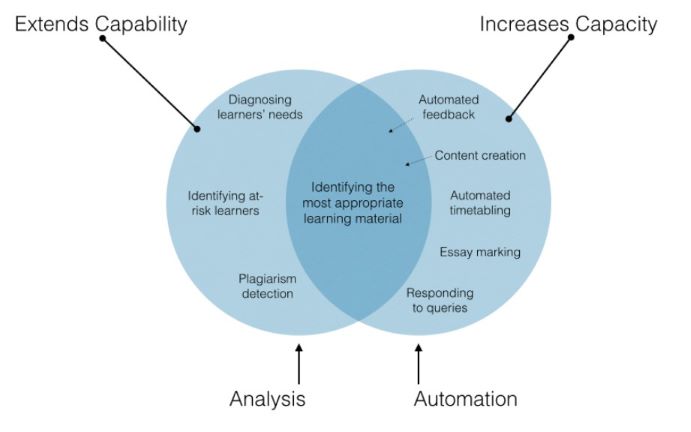The national centre for AI in tertiary education aims to help colleges and universities unlock the potential of AI in education. An important first step along this journey is to pin down AI’s potential by identifying how this innovation can add value to the sector. As a starting point, the Centre has developed the following diagram, which is designed to inform and structure people’s thinking around the overarching benefits of AI.

By breaking down the functions of AI resources into specific tasks, we have identified two underlying (and mutually inclusive) ways in which AI can support educational institutions: by increasing their capacities, and by extending their capabilities.
Increasing capacity
Where it is used to complete tasks such as marking essays, automating timetabling and responding to student queries (via chatbots, perhaps), AI is primarily adding value by increasing the capacity of educational institutions. Each of these tasks can (and usually are) performed by educators or other members of staff. All educational institutions have the expertise and skillsets needed to ensure that student essays get marked, but most institutions lack the capacity to mark a very high volume of essays. A student preparing for an exam by writing multiple practice essays, for instance, is unlikely to expect every single essay to get marked. If AI can be used to mark their essays, however, then this becomes possible.
With the above example, increased capacity translates into increased quantity of provision. But as well as increasing the total volume of essays that can get marked, essay-marking resources could also reduce the total number of hours that educators spend marking. With a reduction in their workload, educators’ time can be freed up to concentrate on higher-impact tasks, leading to better outcomes and a more fulfilling, effective experience for learners.
Extending capabilities
Complementing its powers of automation, AI also adds value because it can analyse and draw insights from data. Educational institutions, for instance, will not always be capable of accurately predicting which students are likely to fail or drop out of a course. Predictive analytics resources, however, may possess this capability. These systems can analyse large datasets and identify patterns of behaviour that tend to predict such adverse outcomes. Because these technologies can process data in ways that are not humanly possible, AI-based predictions can go beyond the intuitions and professional judgements of human members of staff.
The overlap
In the case of predictive analytics, AI’s role is more to inform actions than to execute them, meaning it will not necessarily increase institutional capacity. That said, AI can also be utilised in ways that simultaneously increase institutions’ capacities and capabilities. To give an example, adaptive learning platforms are able to analyse learning data, ascertain learners’ needs, and thus provide learning material that should help meet those needs. These platforms can extend institutions’ capabilities by conducting more fine-grained analysis of learners’ needs than humans are able to. They can also increase the capacity of institutions because, being available on-demand, they can extend the level of provision that learners have access to. Notwithstanding the benefits of cases where AI can extend capabilities whilst increasing capacity, it should be emphasised that whilst AI can do some things better than humans, it can’t necessarily do everything better than an experienced educator. In other words, we should not see this overlapping section of the Venn diagram as a rationale for marginalising the role of human educators.
Grey areas
In the diagram, we have hedged our bets by putting the following tasks: ‘automated feedback’, and ‘content creation’ in the capacity only part of the Venn diagram, with an arrow pointing towards the middle. This is because the ability of AI to perform these tasks in a way that extends capabilities whilst increasing capacity is contingent on the level of insight that AI can uncover through data analysis. All high-quality educators, for instance, are capable of giving students feedback- you could even argue that this skill is what defines a good educator. In order for AI to extend capabilities in this area, it would have to be able to give feedback that was more accurate and data-driven than a human could reasonably provide. Feedback such as “you used alliteration effectively, but aim next time to use a greater range of vocabulary”, does nothing to extend educators’ capabilities. On the other hand, something along the lines of “based on an analysis of similar news articles, if you were to make the following changes to your work…it would be read fully by 70% more people”, would go beyond what you would reasonably expect of educators.
Practical takeaways
As previously mentioned, this diagram and the model that it manifests is designed to inform and structure people’s thinking around the overarching benefits of AI. Whenever you come across a particular application of AI in education, the diagram should help you to ascertain what value this application might confer. How will this particular resource help us do more than we currently can? How will it buy us time, and how can we then use that time in more valuable ways? How will it help us increase the level of service we provide? To what extent does it go beyond the skillsets currently possessed by our institution? Through helping to answer questions like these, we hope that the ‘AIEd value-add Venn diagram’ will help to bring AI’s potential in education into sharper relief.
Find out more by visiting our Artificial Intelligence page to view publications and resources, join us for events and discover what AI has to offer through our range of interactive online demos.
For regular updates from the team sign up to our mailing list.
Get in touch with the team directly at AI@jisc.ac.uk
